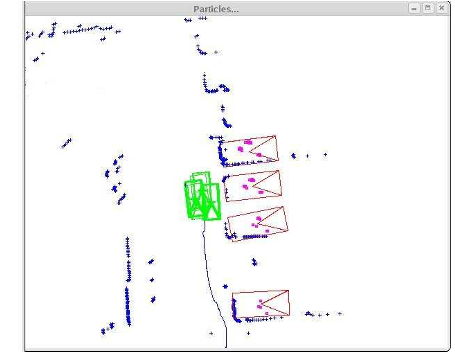




read more











A second stage of filtering is applied to each vehicle hypothesis obtained after the first stage as a form of validation gating in order to reduce the number of false positives.
In this paper, a higher level of representation (vehicles in this case) of the environment is used instead of fundamental geometrical entities.
The general idea is to use only the laser data without artificial or predefined landmarks, CyCab will navigate the car park autonomously while generating a map of its environment.
A metric, the vehicle support, based on the sum of the magnitude of cross products can be used to enforce their conservative approach.
The disadvantage of the vehicle pose hypotheses construction and conservative gating approach is its inability to handle occlusion and false positives are obtained as a result.
The two main criteria for measuring similarity of a current hypothesis and a previously accepted hypothesis are their position and angle.
The current implementation is a naive and unoptimized version of FastSLAM that executes with a frequency of between 4-6Hz on a pentium 4.
a bayesian program is composed of:• the list of relavant variables ; • a decomposition of the joint distribution over these variables; • the parametrical form of each factor of the decomposition; • the identification of the parameters of these parametrical forms; • a question in the form of probability distribution inferred from the jointdistribution.
The authors can infer on positions and orientations of vehicles from segments detected from laser scan data which is analogous to the way line segments are recovered from an ensemble of points.
The equation for calculating the support is given by:support = ∀i, j ∑i6=j| Si × Sj | (1)Intuitively, if a large portion of the length and a small portion of the width is detected, the support will give a low value and vice versa.
7. Due to the conservative approach in validating hypotheses in stage 2, some potential hypotheses are inevitably eliminated in the process (eliminated vehicle hypothesis to the right in fig.
Two bounding rectangles are calculated from the vehicle hypothesis configuration with one rectangle a ratio smaller than the original vehicle size and the other a ratio bigger as illustrated in figure 4.
The most likely group of hypotheses with the same data association for a given observation can be combined together to obtain the landmark to be represented in thefinal map while the rest of the hypotheses are ignored.
LGiven the length L and the width l of the assumed vehicle size, the authors consider the prior probability that the segment belongs to either the length or width is based on the simple ratio of the side in question against the sum of the two sides.
The mechanism of the entire system can be broken down into three fundamental components, vehicle detection, the simultaneous localization and mapping(slam) and the map construction .